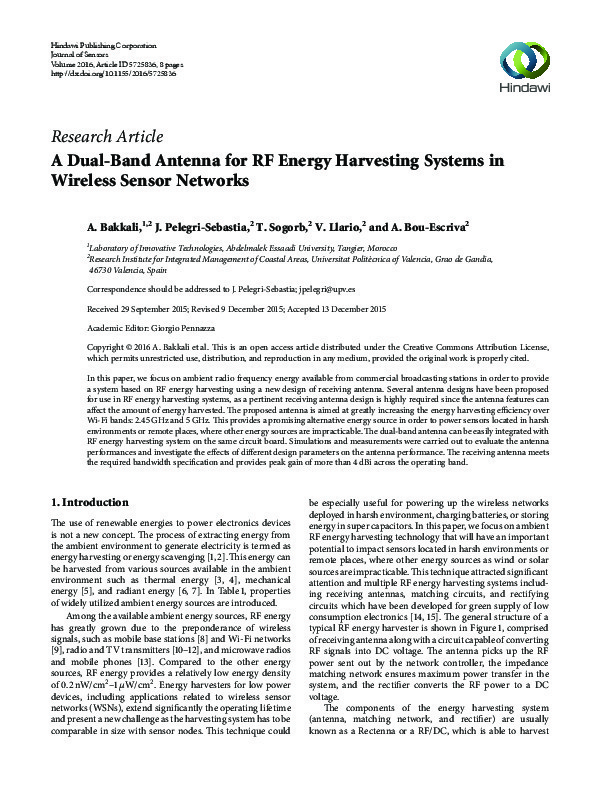JavaScript is disabled for your browser. Some features of this site may not work without it.
Buscar en RiuNet
Listar
Mi cuenta
Estadísticas
Ayuda RiuNet
Admin. UPV
A Dual-Band Antenna for RF Energy Harvesting Systems in Wireless Sensor Networks
Mostrar el registro sencillo del ítem
Ficheros en el ítem
| dc.contributor.author | Bakkali, A.
|
es_ES |
| dc.contributor.author | Pelegrí Sebastiá, José
|
es_ES |
| dc.contributor.author | Sogorb Devesa, Tomás C.
|
es_ES |
| dc.contributor.author | Llario Sanjuan, José Vicente
|
es_ES |
| dc.contributor.author | Bou Escrivà, Antoni
|
es_ES |
| dc.date.accessioned | 2016-04-21T17:22:03Z | |
| dc.date.available | 2016-04-21T17:22:03Z | |
| dc.date.issued | 2016 | |
| dc.identifier.issn | 1687-725X | |
| dc.identifier.uri | http://hdl.handle.net/10251/62814 | |
| dc.description.abstract | In this paper, we focus on ambient radio frequency energy available from commercial broadcasting stations in order to provide a system based on RF energy harvesting using a new design of receiving antenna. Several antenna designs have been proposed for use in RF energy harvesting systems, as a pertinent receiving antenna design is highly required since the antenna features can affect the amount of energy harvested. The proposed antenna is aimed at greatly increasing the energy harvesting efficiency over Wi-Fi bands: 2.45GHz and 5GHz. This provides a promising alternative energy source in order to power sensors located in harsh environments or remote places, where other energy sources are impracticable.The dual-band antenna can be easily integrated with RF energy harvesting system on the same circuit board. Simulations and measurements were carried out to evaluate the antenna performances and investigate the effects of different design parameters on the antenna performance.The receiving antenna meets the required bandwidth specification and provides peak gain of more than 4 dBi across the operating band. | es_ES |
| dc.description.sponsorship | This work was supported in part by EMMAG Program 2014. The tests have been performed under the collaboration with the Electromagnetic Radiation Laboratory (GRE Lab) of the UPV. | en_EN |
| dc.language | Inglés | es_ES |
| dc.publisher | Hindawi Publishing Corporation | es_ES |
| dc.relation.ispartof | Journal of Sensors | es_ES |
| dc.rights | Reconocimiento (by) | es_ES |
| dc.subject | Dual-band antenna | es_ES |
| dc.subject | Rf energy Harvesting | es_ES |
| dc.subject | WSN | es_ES |
| dc.subject.classification | TECNOLOGIA ELECTRONICA | es_ES |
| dc.title | A Dual-Band Antenna for RF Energy Harvesting Systems in Wireless Sensor Networks | es_ES |
| dc.type | Artículo | es_ES |
| dc.identifier.doi | 10.1155/2016/5725836 | |
| dc.rights.accessRights | Abierto | es_ES |
| dc.contributor.affiliation | Universitat Politècnica de València. Departamento de Ingeniería Electrónica - Departament d'Enginyeria Electrònica | es_ES |
| dc.contributor.affiliation | Universitat Politècnica de València. Escuela Politécnica Superior de Gandia - Escola Politècnica Superior de Gandia | es_ES |
| dc.contributor.affiliation | Universitat Politècnica de València. Instituto de Investigación para la Gestión Integral de Zonas Costeras - Institut d'Investigació per a la Gestió Integral de Zones Costaneres | es_ES |
| dc.description.bibliographicCitation | Bakkali, A.; Pelegrí Sebastiá, J.; Sogorb Devesa, TC.; Llario Sanjuan, JV.; Bou Escrivà, A. (2016). A Dual-Band Antenna for RF Energy Harvesting Systems in Wireless Sensor Networks. Journal of Sensors. 2016:1-8. doi:10.1155/2016/5725836 | es_ES |
| dc.description.accrualMethod | S | es_ES |
| dc.relation.publisherversion | http://dx.doi.org/10.1155/2016/5725836 | es_ES |
| dc.description.upvformatpinicio | 1 | es_ES |
| dc.description.upvformatpfin | 8 | es_ES |
| dc.type.version | info:eu-repo/semantics/publishedVersion | es_ES |
| dc.description.volume | 2016 | es_ES |
| dc.relation.senia | 299988 | es_ES |
| dc.description.references | Sudevalayam, S., & Kulkarni, P. (2011). Energy Harvesting Sensor Nodes: Survey and Implications. IEEE Communications Surveys & Tutorials, 13(3), 443-461. doi:10.1109/surv.2011.060710.00094 | es_ES |
| dc.description.references | Bottner, H., Nurnus, J., Gavrikov, A., Kuhner, G., Jagle, M., Kunzel, C., … Schlereth, K.-H. (2004). New thermoelectric components using microsystem technologies. Journal of Microelectromechanical Systems, 13(3), 414-420. doi:10.1109/jmems.2004.828740 | es_ES |
| dc.description.references | Hande, A., Polk, T., Walker, W., & Bhatia, D. (2007). Indoor solar energy harvesting for sensor network router nodes. Microprocessors and Microsystems, 31(6), 420-432. doi:10.1016/j.micpro.2007.02.006 | es_ES |
| dc.description.references | Alippi, C., & Galperti, C. (2008). An Adaptive System for Optimal Solar Energy Harvesting in Wireless Sensor Network Nodes. IEEE Transactions on Circuits and Systems I: Regular Papers, 55(6), 1742-1750. doi:10.1109/tcsi.2008.922023 | es_ES |
| dc.description.references | Mikeka, C., & Arai, H. (2011). Design Issues in Radio Frequency Energy Harvesting System. Sustainable Energy Harvesting Technologies - Past, Present and Future. doi:10.5772/25348 | es_ES |
| dc.description.references | Nintanavongsa, P., Muncuk, U., Lewis, D. R., & Chowdhury, K. R. (2012). Design Optimization and Implementation for RF Energy Harvesting Circuits. IEEE Journal on Emerging and Selected Topics in Circuits and Systems, 2(1), 24-33. doi:10.1109/jetcas.2012.2187106 | es_ES |
| dc.description.references | Vyas, R. J., Cook, B. B., Kawahara, Y., & Tentzeris, M. M. (2013). E-WEHP: A Batteryless Embedded Sensor-Platform Wirelessly Powered From Ambient Digital-TV Signals. IEEE Transactions on Microwave Theory and Techniques, 61(6), 2491-2505. doi:10.1109/tmtt.2013.2258168 | es_ES |
| dc.description.references | Farinholt, K. M., Park, G., & Farrar, C. R. (2009). RF Energy Transmission for a Low-Power Wireless Impedance Sensor Node. IEEE Sensors Journal, 9(7), 793-800. doi:10.1109/jsen.2009.2022536 | es_ES |
| dc.description.references | Md. Din, N., Chakrabarty, C. K., Bin Ismail, A., Devi, K. K. A., & Chen, W.-Y. (2012). DESIGN OF RF ENERGY HARVESTING SYSTEM FOR ENERGIZING LOW POWER DEVICES. Progress In Electromagnetics Research, 132, 49-69. doi:10.2528/pier12072002 | es_ES |








